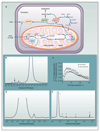Imaging Tumor Metabolism to Assess Disease Progression and Treatment Response
- PMID: 27609841
- PMCID: PMC5321522
- DOI: 10.1158/1078-0432.CCR-16-0159
Imaging Tumor Metabolism to Assess Disease Progression and Treatment Response
Abstract
Changes in tumor metabolism may accompany disease progression and can occur following treatment, often before there are changes in tumor size. We focus here on imaging methods that can be used to image various aspects of tumor metabolism, with an emphasis on methods that can be used for tumor grading, assessing disease progression, and monitoring treatment response. Clin Cancer Res; 22(21); 5196-203. ©2016 AACR.
©2016 American Association for Cancer Research.
Conflict of interest statement
No potential conflicts of interest were disclosed.
Figures


References
-
- Hanahan D, Weinberg RA. Hallmarks of cancer: the next generation. Cell. 2011;144:646–74. - PubMed
Publication types
MeSH terms
Grants and funding
LinkOut - more resources
Full Text Sources
Other Literature Sources

